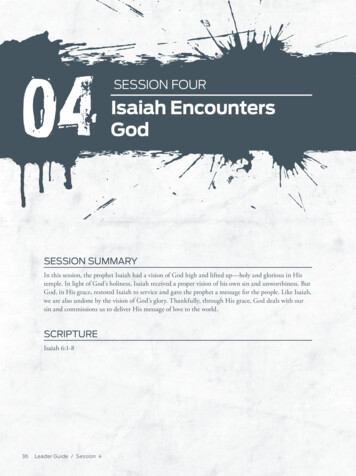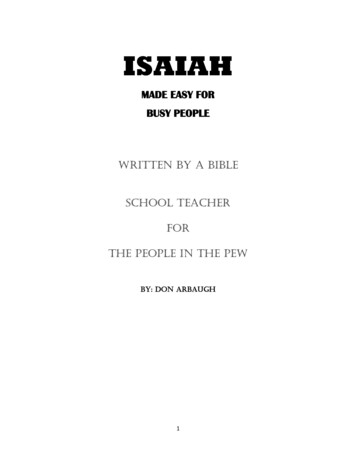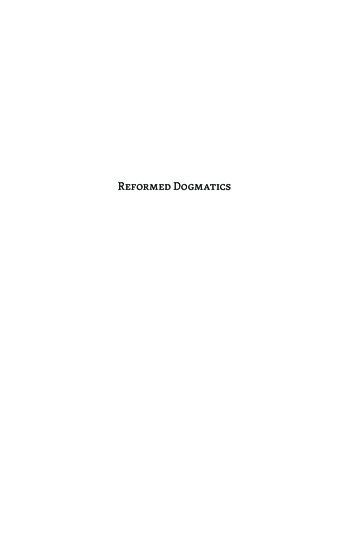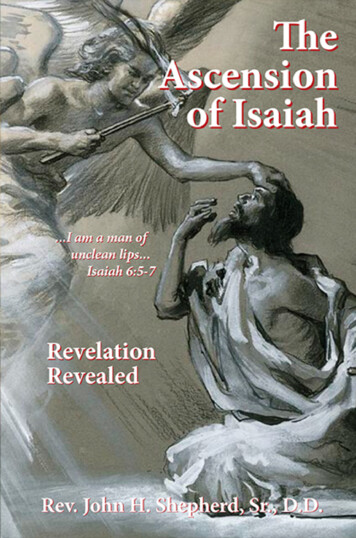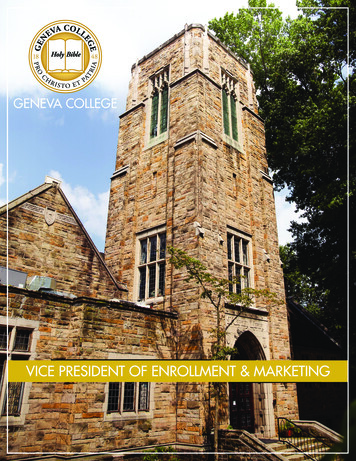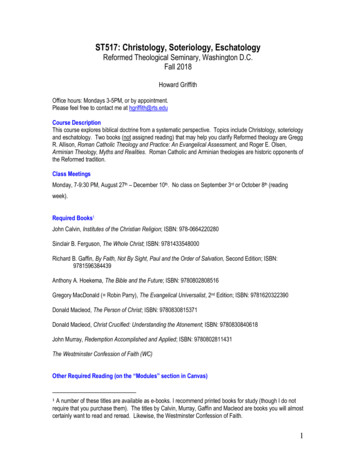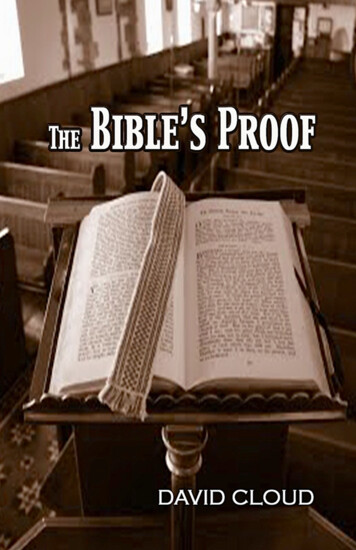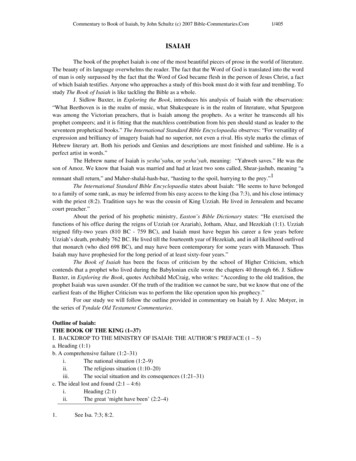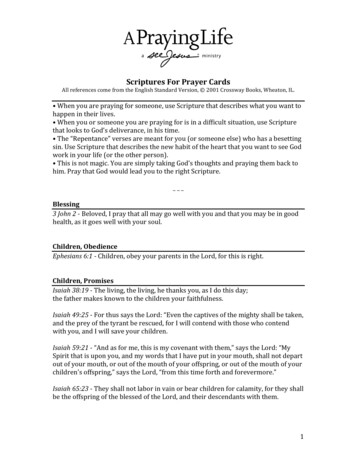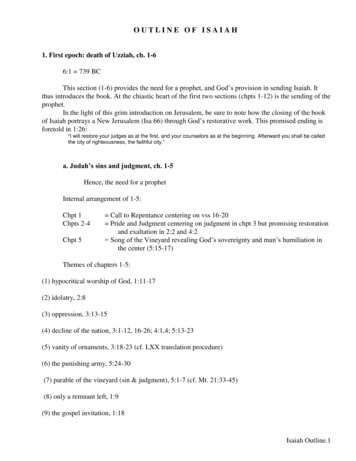
Transcription
OUTLINE OF ISAIAH1. First epoch: death of Uzziah, ch. 1-66:1 739 BCThis section (1-6) provides the need for a prophet, and God’s provision in sending Isaiah. Itthus introduces the book. At the chiastic heart of the first two sections (chpts 1-12) is the sending of theprophet.In the light of this grim introduction on Jerusalem, be sure to note how the closing of the bookof Isaiah portrays a New Jerusalem (Isa 66) through God’s restorative work. This promised ending isforetold in 1:26:“I will restore your judges as at the first, and your counselors as at the beginning. Afterward you shall be calledthe city of righteousness, the faithful city.”a. Judah’s sins and judgment, ch. 1-5Hence, the need for a prophetInternal arrangement of 1-5:Chpt 1Chpts 2-4Chpt 5 Call to Repentance centering on vss 16-20 Pride and Judgment centering on judgment in chpt 3 but promising restorationand exaltation in 2:2 and 4:2 Song of the Vineyard revealing God’s sovereignty and man’s humiliation inthe center (5:15-17)Themes of chapters 1-5:(1) hypocritical worship of God, 1:11-17(2) idolatry, 2:8(3) oppression, 3:13-15(4) decline of the nation, 3:1-12, 16-26; 4:1,4; 5:13-23(5) vanity of ornaments, 3:18-23 (cf. LXX translation procedure)(6) the punishing army, 5:24-30(7) parable of the vineyard (sin & judgment), 5:1-7 (cf. Mt. 21:33-45)(8) only a remnant left, 1:9(9) the gospel invitation, 1:18Isaiah Outline.1
(10) day of Yahweh; shake the earth, 2:12-22(11) promise of renewal through the future “Branch,” 1:26; 2:2-4; 4:2-6b. Isaiah’s call, ch. 6—God provides a prophet to call the people to obedience and holiness6:1, exalted Lordan enthronement festival?6:2, seraphim “burning ones”cf. cherubim, or living creatures, Ezek. 1:5-14; Rev. 4:6-86:3, DSS has two “holies”holiness, the great theme of Isaiah6:8, missionary spiritLXX avoids plurality of deity and translates, “ And who will go for Us?” to “ who will go to thispeople?”3-point sermon: “Woe, Lo, Go”6:9-13, hardening ministry; ctr. 32:3 where eyes/ears are openedbut still a remnant, v. 13*most quoted OT text in NT (found in Mt. 13:14; Mk. 4:12; Lk. 8:10; Acts 28:25-27; cf. Rom.9:18 and 2 Cor. 2:14-16)**Acts 28:25 credits this passage to the H.S.John 12:41 context has Son of God in view2. Second epoch: reign of Ahaz, ch. 7-277:1; 735-715 BCThis major portion consists of three large sections. The backdrop is the threat of Israel and Syriafrom the north, and the growing threat of Assyria. During the reign of Ahaz the Assyrians invaded andthen totally conquered the northern kingdom of Israel (732, 722 BC).Isaiah Outline.2
a. The [unified] Book of Immanuel, ch. 7-12This important and beautiful section of Isaiah comes from ca. 733 BC, when Tiglath-pileser IIIwas expanding his power westward. Syria and Israel were leading the resistance to Assyria.(1) The virgin birth prophecy, 7:1-177:1, 4-6, situation (2 Kings 16:5-8)7:3, fuller was outside the city7:8, dissolution of Ephraim/Israel as a people within 65 years733 BC 65 years 668 BCduring Ashurbanipal (669-633 BC); Ashurbanipal “Osnappar” in Ezra 4:10 (cf. 2Kings 17:24, unnamed); he is credited with the thorough mixing of populationsmany see problems, try to link 65 years to the age of Rezin or of Pekah (cf. 8:4); e.g., R. L.Harris, “Isaiah,” ZPEB III, 324, says it is Rezin’s 65th year of age (see below)7:10-17, the sign controversy: cf. Lk. 2:22-35 where Simeon calls Jesus “a sign” (Lk. 2:34; cf. Lk. 2:40,52)7:12, tempt God; Dt. 6:16; cf. Mt. 4:77:13, switch to plural you, (in vs. 14) the nation, “house of David”but singular again in v. 16; cf. house of David, Mt. 1:20“virgin,” hm6l4i5 almah, 7 times in OT, never married: Gen. 24:43; Ex. 2:8; Ps. 68:25 (cf.Ps. 46:1 —see NASB; 68:25, alamoth, musical instruments?); Prov. 30:19 —see K&D;Song 1:3; 6:8cf. masc. form in 1 Sam. 17:56; cf. 20:22 “unmarried girl,” Old Eng. “maiden”; assumed to be a virginother words like hV6a1 ‘ishah and hl6t7B4 bethulah do not necessarilyindicate a young maiden; bethulah could be married or could be an old woman(cf. bethulah in Joel 1:8, young widow.)Isaiah Outline.3
Only almah denotes an unmarried maiden; hence this choice of words is deliberate.The Offspring of this unmarried young woman would therefore be either 1) illegitimate,or 2) a miracle sign ChildLXX translated Isa. 7:14 using parqhnov parthenos, Greek technical term for virgin(never married); NT does same in Mt. 1:23 (note context in Matthew [1:25] wherevirgin idea prominent)(more discussion in Hengstenberg, Christology of the OT, I, 416-424 (1854); Young Isaiah, I,286-89; Hindson’s Isaiah’s Immanuel)“Immanuel,” la2WnM6i1 immanu’el, “With us [is] God”; cf. 8:8,107:15, “poor food” (ctr. v. 22ff.); from pasture land, not tilled7:16-17, before the Messiah is a reasoning child, two things:1) Rezin and Pekah gone2) Assyria to invade JudahThe place of Mahershalalhashbaz in parallel relation to this prophecy (8:1-4) seems tohave been an additional revelation made to Isaiah at a different time, although thenatural point of reference from the perspective of Ahaz might be a child born of acontemporary maiden.Two views relating the “near” and “far” features of this prophecy:1.R. Laird Harris: vv. 16,17 are 2 fulfillments separated by time. Vs. 16 is Rezin and Pekah in732, and vs. 17 is Sennacharib in 701.“The passage thus declares that before the Messiah Immanuel is born of a virgin and is weaned, the Assyrian willcome and depopulate the land. . . . Isaiah did not set a date, for he did not know the date. Elsewhere he speaks of the comingwonderful king of David’s line without giving the time. The coming of the Rod of Jesse is prophesied (11:1) in closesuccession to the downfall of the Assyrians (10:24-34). Isaiah was only to know that at an unspecified time the Messiahwould come, and he warns Ahaz to mend his ways, because before the Messiah would come, the Assyrians would invadeand bring tragedy greater than the division of Ephraim from Judah. Actually there is no information that this invasion camebefore the days of Sennacherib in 701 BC, thirty years after the prophecy was given. It could not in any case refer to a childof Ahaz or of Isaiah.” (“Isaiah,” ZPEB, III, 324)2.732.A. A. MacRae: vv. 15ff. is one unified event of prophecy, i.e., Assyria’s invasion of Israel in(differs from Harris to make the Assyrian invasion of v. 17 that of 732 BC, not 701 BC)Isaiah Outline.4
“In his rejoinder (vv. 13, 14) Isaiah expressed a strong rebuke, not simply to Ahaz, but to the entire house ofDavid, of which Ahaz was a very unsatisfactory representative. He spoke to the whole house of David, giving assurance thatit would not always have such unworthy representatives as Ahaz, but that God Himself would provide, as the true head ofthe house of David, One born of a virgin, whose name can properly be called Immanuel (“God with us”).“In vv. 15ff, the prophet turned his attention away from the house of David as a whole and back to Ahaz. Nostatement had been made as to when Immanuel would come. On the assumption that He might be born immediately, thetime that would be involved in His growth was used as a measuring stick to show how soon God would cause Ahaz’sfaithless scheme to produce results quite different from what he had expected. Supposing that the child were to be born rightat that time, before he would reach the age when he could make simple choices, the two kings who were menacing Judahwould have disappeared (v. 16), and the great depopulation caused by the Assyrian invasion would have resulted in asituation where crops that require human labor would be greatly diminished.“Thus v. 14 pointed to a single event that would occur 700 years later whereas vv. 15ff described the situation thatwould develop in the immediate future.” (“Prophets and Prophecy,” ZPEB, IV, 899, 902)(2) God’s use of Assyria, 7:18 - ch. 10This topic has already been introduced in ch. 7; now Isaiah further develops Assyria’s relationto God and to Israel, and the way that God will finally destroy Israel’s enemies and rule throughthe Messiah, Immanuel.7:18-25, Assyrian invasion brings judgment on Judahch. 8, more immediate judgmentAssyrian conquest starts soon, will reach Judah “up to the neck” (v. 8)8:6, “waters of Shiloah (h5l v1 shiloach),” spring used for Hezekiah’s Siloam Tunnel8:7, River Tigris, near Nineveh8:8-10, opponents can touch Immanuel’s Land only by permission8:18, Isaiah’s two children have symbolic names: Shearjashub and Mahershalalhashbaz9:1-7, promised time of blessing when light replaces gloomvv. 1-2, cf. Mt. 4:14-17vv. 6-7, Messiah and his kingdom (note antecedent in 7:14)Deity and Humanity of Immanuel is balanced in the symmetry of the four titles in 9:6“Wonderful. . .” cf. Angel of the Lord in Jdg. 13:18“Counselor,” cf. 11:2“the mighty God,” cf. 10:21 (57:15)“everlasting Father,” cf. Ps. 103:13; ctr. Is. 57:15Isaiah Outline.5
“prince of peace” King of Salemv. 7 outgrowth of Davidic Covt and protevangelium of Gen. 3:169:8 - ch. 10, judgment through and upon Assyria10:5-12, note God’s sovereignty and theodicy (cf. Habakkuk)10:20-22, only a “remnant returns” to God, fulfilling the symbol of Isaiah’s son, Shearjashub,7:3(3) The Messiah and his kingdom, ch. 11-1211:1, branch of Jesse; cf. 4:2shoot – tree cut; cf. Mt. 3:10; ctr. II Sam. 23:5Mt. 2:23, Nazarene; branch rx3n3 netser11:2-5, qualifications to rulev. 2, Spirit distinct from Messiah (cf. 61:1)—seven-fold blessing? cf. Rev. 4:5v. 4, *breath of His lips**NT citations, 2 Thess. 2:8; Rev. 19:15*, indicate that this prophecy is yet future(Ps. 2:9; Rev. 2:27)He shall strike the earth with the rod of His mouth,And with the breath of His lips He shall slay the wicked. – Isa 11.4And then the lawless one will be revealed, whom the Lord will consume withthe breath of His mouth and destroy with the brightness of His coming.– 2 Thess 2.8Now out of His mouth goes a sharp sword, that with it He should strike thenations. And He Himself will rule them with a rod of iron. – Rev 19.15[a]11:6-9, nature in harmony (cf. Rom. 8:22)Isaiah Outline.6
Calvin in his commentary recognizes the fulfillment of this passage in the animal kingdom afterthe return of Christ, but he says that the passage “chiefly means” that Christians of all differenttemperaments or dispositions will live harmoniously in the church.On the other hand, amil Young states that the passage refers to literal animals in the newheavens and new earth (cf. Isa. 65:17-25; 66:22-24).ch. 12, psalm of praise in the kingdom(4) Symmetrical Structure of the Book of ImmanuelApromise: Messiah’s birthch. 7Bch. 8CB1A1ch. 10ch. 11-12judgment (by Assyria)ch. 9promise: Messiah’s birth and kingdomjudgment (on Assyria)promise: Messiah’s kingdomb. Prophecies against the nations, ch. 13-23Babylon, ch. 13 - 14:23, holds the first place in judgment, not Assyria! And the fall of Babylon in chpt21 is the center focus of this [broader] section of prophecies against the nations, chpts 13-27.(See Dorsey outline, p. 221.)ch. 13, note apocalyptic language in vv. 6, 9-1313:16, cf. Ps. 13713:17, accuracy about the Medes, an “inorganic element,” proves divine source of prediction13:20, desolation; see Urquhart, Wonders of Prophecy, 138-50; “Bedouins shrink from it insuperstition” –Delitzsch14:4-20, doom of king of Babylon, or “Who was Lucifer?” Young: “Babylonian dynasty conceived as an ideal person” Satan?Isaiah Outline.7
per Tertullian, Origen, Gregory the Great, etc.cf. Ezek. 28; Lk. 10:18Old Scofield, “Lucifer, ‘day-star,’ can be none other than Satan”; New Scofield agrees,calls Lucifer “the real though unseen ruler of the successive world powers”v. 12, ll2h2 helel, “shining one,” from halal, shineKJV, “Lucifer” follows the VulgateASV, “day-star”NASB, NIV, “morning star”“The exposition of this passage, which some have given, as if it referred to Satan, has arisen from ignorance,for the context plainly shows that these statements must be understood in reference to the King of theBabylonians. But when passages of Scripture are taken up at random, and no attention is paid to thecontext, we need not wonder that mistakes of this kind frequently arise.” –Calvin Commentary on Isaiah.Calvin goes on to call the Satan interpretation “inventions and useless fables.” better to take Lucifer within context as king of Babylon, perhaps Belshazzar (14:19,31),recognizing the poetic language. He is counterfeit messiah (cf. 2Pet 2.19 and Rev. 22.16).For a fascinating comparison between the false king of Isaiah 14 and God’s Servant of Isaiah53, see Dorsey’s The Literary Structure of the OT, pp. 230-31.Assyria, 14:24-27Philistia, 14:28-32 (fulfilled 711, 701)v. 28, death of Ahaz dates this prophecy, 715 BCMoab, ch. 15-16 (fulfilled 722)destroyed by Shalmaneser V and Sargon II16:4-6, Moabites hide Jews, or Jews hide Moabites, or both?cf. Rev. 12:6,14v. 5, throne of David to provide refuge16:14, three years from when?3 years from death of Ahaz would be ca. 712; but Moab destroyed in 722; Young suggestsdifferent date for v. 14 (725 bc)Isaiah Outline.8
Damascus, ch. 17mostly fulfilled in Assyrian conquest of 732 BCEthiopia, ch. 18Egypt, ch. 19-2019:4, great variety of interpretations of the “cruel master over Egypt”:various Assyrian rulersvarious Egyptian tyrants4 world kingdoms (Young)little horn of Dan. 719:16-25, future theocratic kingdom20:1, synchronismSargon II (721-705), great campaign against Ashdod in 712 BC“Tartan” king’s viceroy, military title (NIV “supreme commander”), cf. 2 Kings 18:1720:2-4, Isaiah naked and barefootonly recorded unusual action of this propheta 3-year signperhaps fulfilled in 712 by Sargonperhaps fulfilled in 682, when Essar-haddon carried away captives from EgyptBabylon, 21:1-10again, after chpts. 13 – 14:23, and preceding chpt.“wilderness by the sea”Isaiah Outline.9
v. 1, sea “great plain watered by a mighty river (cf. Gen. 11:2; Isa. 23:13; 27:1 — cf. Nile: 19:5)”–Youngv. 2, defeated by Elam, Persia, and Mediav.5, last orgy in Babylon, phps Belshazzar’s feastv. 9, repeated in Rev. 14:8; ch. 17-18Edom, 21:11-12 Dumah, Gen. 25:14Arabia, 21:13-17modern Jordan and west side of Saudi ArabiaJerusalem, ch. 22“valley of vision,” vv. 1,5vv. 1-14, to be destroyed; sin of complacencyvv. 15-25, treasurer Shebna to be exiled, replaced by Eliakim (cf. 36:3, 22; 37:2)perhaps Shebna demoted to “scribe,” or perhaps this is another Shebnacf. Roland de Vaux, Ancient Israel, I, 129-31, who shows this position to be the highest underthe king, “master of the palace”Tyre, ch. 23v. 16, harlot, commercialism; cf. Nah. 3:4; Rev. 18:3vv. 15-18, 70 years, then holinessgreat variety of interpretations:Nebuchadnezzar besieged Tyre 13 years, evidently captured it (but wealth and shipsmoved away, cf. Ezek. 29:17-18). 70 years time of Neo-Babylonian empire to thebeginning of Persian empire (Delitzsch, pp. 416-21)perhaps gap after v. 15; v. 16 period in between; v. 17 future kingdomIsaiah Outline.10
c. Isaiah’s Apocalypse, ch. 24-27This section is unique in that many verses are clearly eschatalogical. There are manysimilarities to the NT book of Revelation. There are few “near” references, and there is little historicalbackground.ch. 24, judgment on the earth, and the reign of Yahwehvv. 5,6, breach of covt brings fiery judgmentv. 22, fits with millennium? cf. Rev. 20:3ch. 25, institution of the kingdomv. 6, banquet feast—Rev. 19esp. v. 8 cf. Ps. 116:8; I Cor. 15:54,26; Rev. 21vv. 10-12, Moab an example of all enemies; as Edom in ch. 34ch. 26, song in the kingdomv. 11, judgment by firev. 12, sovereignty; cf. Phil 2:13v. 14, wicked dead viewed as a groupv. 19, resurrection of the righteous dead (“they” Lord’s “dead ones”; Hebrew says “my deadones will rise”)*contrast v. 14 where wicked dead not raisedv. 20, protection during time of God’s wrathphps. related to Rev. 12:1-6; 13:1 (Isa. 27:1, serpent)v. 21, phps. parousia of Rev. 1:7ch. 27, regathering of Israelv. 1, “Shalyat” - seven headed serpent in Ugaritic loreIsaiah Outline.11
esp. vv. 12-13; last trump / feast of trumpets. Cf. trumpet of I Cor. 15:52; I Thess 4:163. Third epoch: first 15 years of Hezekiah, ch. 28-39—715-701 BCa. Warnings, judgments, blessings for God’s people, ch. 28-35ch. 28, Ephraim’s bad example to Judah, and its coming destructionvv. 7-10, drunkenness destroys discernmentvv. 9,10, mocking of Isaiah’s pedagogic style of preachingv. 11, “tongues” of judgment (promised curse of Dt. 28:49) replace simplicity of Isaiah’s simpleteaching; meaning of 1 Cor. 14:21,22See O.P. Robertson’s interpretation of strange tongues in connection with I Cor.14: Westminster Journal, 38:43vv. 14-22, God is the best allyv. 16, cornerstone (allusion to Ps. 118:22); NT reference: Rom. 9:33; 10:11; 1 Pet. 2:6ch. 29, Jerusalem’s coming siege and deliverancevv. 1-4, siege“Ariel” phps “Lion of God”vv. 5-8, deliverance from enemiesvv. 9-16, their sinvv. 17-24, final righteousnesspossibly fulfilled in 701 BC, invasion of Sennacherib; but probably eschatalogical; cf.Zech. 14; Lk. 21; Rev. 12; end of chapter seems to fit with final kingdomch. 30-31, denunciation of Egyptian allianceIsaiah Outline.12
as in ch. 2830:1-14, sin involved30:15-33, deliverance for remnant31:1-3, Egypt’s helplessness31:5, Passover protection; cf. Mt. 23:37 cf. Is. 30:1531:4-9, Yahweh to protect Jerusalemch. 32, kingdom blessings after destructionv. 1, king and princes; cf. 1 Cor. 6:2; Rev. 20:4-6future kingdom; vv. 1-5, 15-18*v. 3, second advent vs. first advent of Is. 6:10ch. 33, destruction of Assyria and salvation of Jerusalemcf. Isa. 10:5-34ch. 34, day of vengeance on Edomvv. 8-17, animals to take over foreverNote. Edom used here as example, as Moab in 25:10-12ch. 35, messianic blessingsv. 3, cf. Heb. 12:12vv. 5-6, Mt. 11:2-6v. 10, cf. Rev. 7:17b. Historical interlude, ch. 36-39—701 BC, cf. 2 Kings 18-20More than an interlude, this historical section is the centerpiece of Isaiah showing the transitionfrom imperial Assyria to the spiritual-political threat of Babylon. Babylon in the Book of Isaiah isstructurally juxtaposed against Jerusalem that is meant to be God’s holy witness in the world.Isaiah Outline.13
Dealings with Assyria, ch. 36-37Sennacherib’s campaign in Judea (see under historical background in Micah)36:2, the Rabshakeh, NIV “field commander”36:11, Aramaic the lingua franca, not yet known by most Jews37:7, Isaiah’s prophecy: Sennacharib to hear a rumor of war from back home; returns to be killedlater by the sword, v. 3837:8, Sennacherib’s campaign against all fortified citiespictures of Lachish campaign, ANEP#371-74, line drawings in ANE #100-02good discussion and suggested order ofevents, Oswalt Isaiah, pp. 11-1337:14-20, Hezekiah’s prayer37:36-38, death of Sennacherib, ANET, p. 288Dealings with Babylon, ch. 38-39ch. 38, Hezekiah’s illness, ca. 700 B.C.v. 5, given 15 years more; 11 years co-regent with Manassehv. 8, sign of the sun dialvv. 10-20, Hezekiah’s praisevv. 18-19, intermediate state; la v4 sheol uncertain place of dead; cf. II Cor. 5:1-4ch. 39, visit from the Babylonian envoysv. 1, Merodach-baladandiscussion in Leon Wood, p. 363, n. 78721-710, rule Babylon703-702, rule Babylon againIsaiah Outline.14
after 702, “he continued his opposition to Assyrian control as a refugee in Elam. It waslikely during this time that he sought the support of Judah by means of this embassy.”vv. 6-7, Babylonian captivity predicted; Jewish eunuchs in Babylonv. 8, Hezekiah’s shortsighted reactionvv. 6-8, provides transition to second half of Isaiah4. Fourth epoch: last 15 years of Hezekiah, ch. 40-66—701-686 BCWith the ultimate doom of Jerusalem at the hands of the Babylonians predicted at the end ofchapter 39, and with Hezekiah’s response, “There will be peace and security in my time,” Isaiah turnshis attention away from his own contemporaries to those Israelites who will suffer in the future, and tothe remnant who will finally be delivered and restored. This change in perspective has led many toposit two authors. But in its context this new outlook in Isaiah is eminently proper.a. Babylonian exile and deliverance, ch. 40-48note on the Lord’s servant Key theme in chapters 40-55references which contain the term, together with suggested interpretation; starred passage (*)indicates major Messianic passage:41:8-9*42:1-942:1943:1044:1-2, 2144:2645:448:20*49:1-6*50:4-10*52:13–ch. 53IsraelMessiahIsraelIsraelIsraelIsaiah (but cf. 43:10; 42:19)IsraelIsraelMessiah (as head of Israel)MessiahMessiahProblem: sometimes the servant is plainly Israel (41:8-9)but other times the NT indicates Jesus is Isaiah’s servant (52:13 – ch. 53)Is. 53 is cited 10 times in NT: Mt. 8:17; Lk. 22:37; Jn. 12:38; Acts 8:32; Rom. 10:16;15:21; Heb. 9:28; 1 Pet. 2:22, 24, 25Isaiah Outline.15
Solution: not just one servant, but one of two or perhaps three—Israel, Messiah, perhaps Isaiahhimselfcompare other examples of varying identity of God’s servants :Jer. 27:6Jer. 46:27-28Ezek. 37:24-25Hag. 2:23Zech. 3:8Mal. 4:4NebuchadnezzarJacob (nation)Jacob & “David” ( Messiah)ZerubbabelBranch of DavidMosessee progression in Isaiah 49:3-6: Israel – Messiah, the true Prince of God*Isaiah 53 can hardly refer to Israel, who was being punished for sin; and the remnant’spunishment was not vicarious. The NT requires a messianic interpretation: the term paiv (pais)in Acts 3:13, 26; 4:27, 30 should be translated “servant,” not “child” (cf. Bruce Acts, p. 193).Note how Peter identifies this “Servant” with a “prophet like Moses,” 3.22.contents of ch. 40-48ch. 40, consolation from the sovereign God:sovereign in power (12,22), wisdom (13,14,26) and mercy (2,11)v. 2, punishment is fulfilledv. 3, theme of John the Baptistcf. Mal. 3:1; 4:5-6; Mt. 3:1-3ch. 41, God the source of deliverancevv. 8-10, servant Israel not to fearvv. 21-24, idols worthlessv. 25, deliverer from north (Cyrus); cf. Jer. 50:341:25 "I have raised up one from the north, And he shall come; From the rising of the sun he shall callon My name ;”ch. 42, the two servants contrastedIsaiah Outline.16
vv. 1-9, the righteous servant: Messiahvv. 18-25, ctr. the blind and deaf servant: IsraelIsrael’s image is in keeping with God’s revelation of them in Isa 6:9,10. Contrast therighteous Servant whose ear is open (Isa 50:5).ch. 43-45, the servant Israel’s delivery under Cyrussome eschatalogical references—43:5-7, 19-21, 25; 44:3; 45:17, 2344:3, possible Pentecostal reference44:3 “For I will pour water on him who is thirsty, And floods on the dry ground; I will pour My Spirit onyour descendants, And My blessing on your offspring;”44:26, servant appears to be Isaiah (see note above)44:24 - 45:7, the Cyrus prophecyCyrus named in advance—45:3-4, 11 (fulfilled in Ezra 1)see Allis, Unity of Isaiah, ch. 4-5God shown to be the only true God; e.g., 44:6; 45:5, 22150 years after this prophecy, God fulfilled it in the career of Cyrus thePersian, who destroyed the Babylonian empire, and permitted the Jews to returnto Jerusalem and reestablish their temple worship. An outstanding contemporarysource is the Cyrus Cylinder (536 BC; ANET 315-16; picture in New ISBE1:847).ch. 46-47, Babylon’s useless idols, and fallch. 48, God to deliver Israel for his glory, not for their righteousnessvv. 1-11, for God’s gloryv. 14, Babylon destroyedIsaiah Outline.17
v. 15, Cyrus implied*v. 16, the Trinity48:16 "Come near to Me, hear this: I have not spoken in secret from the beginning; From the time that itwas, I was there. And now the Lord GOD and His Spirit Have sent Me."vv. 18-19, Retrospection on conditionality of Mosaic covenantThis section of Isaiah (ch. 40-48) shows how God’s servant Israel does not deserve salvation orthe promised theocratic kingdom, but it also shows that God will bring these blessings anyway. It thusleads logically to the next section, which answers the question, “How can God justly bless thisdisobedient servant?” The answer lies in the suffering righteous servant of the Lord, the Messiah (ch.49-55), Who acts as the new Israel in behalf of Israel.2. Salvation through the Lord’s righteous servant, ch. 49-55a. Messiah’s appointment and humiliation, ch. 49-5049:1-6, important servant sectionIs servant both Israel and Christ, or Christ as representative of Israel? (see note above)SERVANT1)Redeems Israel - 5,62)From the womb - 1,53)Epitome (corporate solidarity) of everything Israel should have been49:3 "And He said to me, 'You are My servant, O Israel, In whom I will be glorified.' 5 " And now theLORD says, Who formed Me from the womb to be His Servant, To bring Jacob back to Him, So thatIsrael is gathered to Him ( For I shall be glorious in the eyes of the LORD, And My God shall be Mystrength), 6 Indeed He says, 'It is too small a thing that You should be My Servant To raise up the tribesof Jacob, And to restore the preserved ones of Israel; I will also give You as a light to the Gentiles, ThatYou should be My salvation to the ends of the earth.'"perspective transition: Israel – Messiah; cf. “righteous vs. deaf servant” of ch. 42:Messiah, Israel49:4, cf. 42:4; cf. Jesus’ crucifixion in ch. 50, 5349:6, “Light of Gentiles” cf. Acts 13:4749:7-13, results of Messiah’s workv. 8 cited in 2 Cor 6:2; “accepted time” Year of JubileeIsaiah Outline.18
49:8 “Thus says the LORD: "In an acceptable time I have heard You, And in the day of salvation I havehelped You; I will preserve You and give You As a covenant to the people, To restore the earth, Tocause them to inherit the desolate heritages; 9 That You may say to the prisoners, 'Go forth,' To thosewho are in darkness, 'Show yourselves.'”49:14-26, resulting confidence of Israelvv. 15-16, God’s love for Israelvv. 22-23, “Jewish supremacy”50:1-3, God looks for a redeemer50:4-10, another important servant passageMessiah to be the Redeemerv. 5, “The Lord GOD has opened My ear; And I was not rebellious, Nor did I turn away.”Interpretations:OR1. cf. Ps. 40:6 (LXX) in Heb. 10:5-7 obedient heart vs. “deaf servant” of ch. 422. ctr. ear piercing of Ex. 21:6 dedicated servantv. 6: “shame and spitting” cf. Mt. 26:67; 27:30; back 27:26; Jn. 19:1note: “my cheeks,” Heb. yjl lechi, “jaw, cheek”; implies beard for JesusChrist shows never any sin or rebelliousness throughoutb. Promised deliverance to Jerusalem, ch. 51 - 52:1251:3, Eden’s return promised (cf. Ezk. 28:13)This deliverance is based upon the work and sacrifice of the righteous servant of Yahweh.tribulation, then glory; e.g., 51:17, 22; 52:4, 7-1052:11, principle applied in 2 Cor. 6:17 (cf. Haggai 2:12-14)Is. 52:11 Depart! Depart! Go out from there, Touch no unclean thing; Go out from the midst of her, Beclean, You who bear the vessels of the LORD.”c. The suffering servant, 52:13 - ch. 53Isaiah Outline.19
“servant” — 52:13; 53:11This is the last servant passage in Isaiah. **This Servant is Messiah (not Israel) because1) He is righteous; 53:112) He suffers vicariously; 53:4,5,8,10-12KNOW {3) the antecedent Servant passage (ch. 49,50) flows easily into this same identity4) the NT shows a Messianic fulfillment (10X)52:13,15 (Is. 56:3-5) cf. interest of the eunuch in Acts 8:33-35“sprinkle many nations” vs. “astonish many nations” of LXXServant will be “high and lifted up.” This phrase is found only in Isaiah and normally applies toGod. Comparing 52: 13 with 6:1, O.P. Robertson notes that the apostle John can say that Isaiah himselfbeheld the glory of Jesus upon the throne:38John 12:37-41 But although He had done so many signs before them, they did not believe in Him,that the word of Isaiah the prophet might be fulfilled, which he spoke: "Lord, who has believed our39report? And to whom has the arm of the LORD been revealed?" Therefore they could not believe,40because Isaiah said again: "He has blinded their eyes and hardened their hearts, Lest they should see41with their eyes, Lest they should understand with their hearts and turn, So that I should heal them."These things Isaiah said when he saw His glory and spoke of Him.53:4,5, cf. Mt. 8:16,1753:9, 11, righteous; OT concept of righteous includes faithfulness to covenant, resulting in deliverancefor covenant people, in spite of their unworthiness (cf. Ps. 71, 143)52:14; 53:2-5,7-12, suffering; fulfilled in passion of Christ; see NT references above52:15 (pbly.); 53:4-6, 8, 10-12, vicarious suffering; leads to forgiveness and blessing on sinners; notappropriate for Isaiah himself or for faithful remnant of Israel52:13, 15;53:10-12reward for the suffering servant (vv. 10,12 are proof texts for “covt of redemption”)53:11, cf. DSS, LXX, NIV (“ to see the light of life” resurrection)How is this suffering servant passage fulfilled? —in Isaiah? Israel? Sacral kingship (cf.Mowinckle, or Harris “Isaiah,” ZPEB 3:326)? Messiah?Messiah is best; by process of elimination, by context, by exact fulfillments (e.g., 52:14;53:2,5,7,9)Isaiah Outline.20
d. Israel’s future restoration, ch. 54-5554:4-8, cf. Hos. 2-3; wife motif in vs. 554:9-10, “covenant of peace”compared to Noah’s (Is. 24:5,6)Covenant in Isaiah Davidic 55:3 New Covt 59:21; 61:854:11-13, kingdom blessings for future; cf. language of Rev. 21:10-27ch. 55, Gospel of Isaiah: appeal to repent and to receive these blessingsFulfillment of Davidic Covt (55:3) leads to removal of the curse3. The sins of Judah, ch. 56 - 59:15 (this section begins Isaiah III for the critics)note Sabbath emphasis, 56:2-8; 58:1,13-14Sabbath keeping a sign of belonging to the covt community (vs. 6) in exile in face of loss ofceremonies56:7, OT universal appeal to all nations: “house of prayer for all peoples”4. Zion’s Redeemer and his kingdom, 59:16 - ch. 6659:16-21, Yahweh himself provides salvationNew Covt language: vs. 21Paul is familiar: Eph. 6 cf. Is. 59:17, 49:2, 52:7Isaiah Outline.21
ch. 60-62, description of promised kingdom (millennial)some Bibles: ch. 59 —“ judgments on Israel”ch. 60 — “blessings on the church”61:1, Baptism of Jesus (cf. Acts 10:38); cf. 42:1two advents in vie
a. The [unified] Book of Immanuel, ch. 7-12 This important and beautiful section of Isaiah comes from ca. 733 BC, when Tiglath-pileser III was expanding his power westward. Syria and Israel were leading the resistance to Assyria. (1) The virgin birth prophecy, 7:1-17 7:1, 4-6, si
